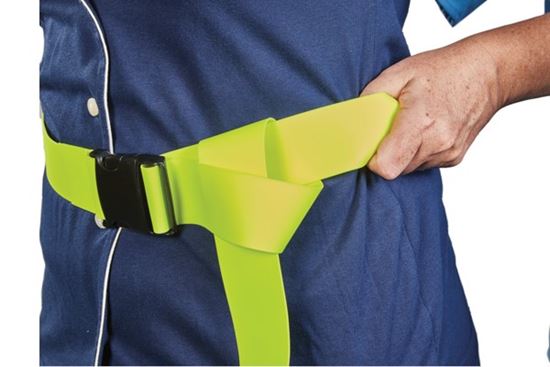-
Home
-
Vinyl Gait Belts: Essential Tools for Patient Mobility
Vinyl Gait Belts: Essential Tools for Patient Mobility
March 14, 2024
 Gait belts, also known as transfer belts, are indispensable tools in healthcare settings for assisting patients with mobility challenges. Among the various materials used for these belts, vinyl has gained popularity due to its distinct advantages. In this guide, we will explore the benefits of vinyl gait belts, how to use them properly, and answer common questions related to their usage.
Gait belts, also known as transfer belts, are indispensable tools in healthcare settings for assisting patients with mobility challenges. Among the various materials used for these belts, vinyl has gained popularity due to its distinct advantages. In this guide, we will explore the benefits of vinyl gait belts, how to use them properly, and answer common questions related to their usage.
What Are Gait Belts?
Gait belts are typically used by healthcare professionals to provide support and stability to patients during transfers or ambulation. They are designed to encircle the patient's waist, allowing the caregiver to hold onto the belt and guide or support the patient safely.
Advantages of Vinyl Gait Belts
Vinyl gait belts offer several benefits over their counterparts made from other materials, such as fabric or leather:
- Durability: Vinyl is a robust material that withstands frequent use and is resistant to wear and tear. This makes vinyl gait belts a cost-effective option for healthcare facilities.
- Ease of Cleaning: Unlike fabric belts, vinyl gait belts can be easily wiped down and disinfected, which is crucial in maintaining hygiene and preventing the spread of infections in healthcare settings.
- Water Resistance: Vinyl's water-resistant properties make it ideal for use in environments where exposure to fluids is common, such as during patient bathing or incontinence care.
- Low Allergen Risk: Vinyl gait belts are less likely to cause allergic reactions compared to those made from latex or certain fabrics, making them suitable for patients with sensitive skin.
Choosing the Right Gait Belt
When selecting a gait belt, healthcare professionals should consider the following factors:
- Patient Needs: The patient's size, weight, and mobility level will determine the appropriate belt size and type. It's essential to choose a belt that can wrap around the patient's waist with enough extra length for the caregiver to hold onto securely during transfers or ambulation.
- Caregiver Comfort and Safety: The belt should provide a secure grip for the caregiver to prevent strain or injury. Some belts include additional loops or grips to aid with safe patient transfer.
- Infection Control Protocol: In settings with high infection risks, a belt that is easy to clean and disinfect, like vinyl, may be preferred. Disposable and reusable gait belts are available, depending on your facility’s protocol.
Do You Have to Be Trained to Use a Gait Belt?
While using a gait belt may seem straightforward, proper training is essential to ensure safe and effective transfers. Caregivers and healthcare professionals should receive training on how to properly position the gait belt on the patient, how to secure it in place, and how to safely assist the patient during transfers. Improper use of a gait belt can result in accidents or injuries, so it is crucial to undergo training before using one.
How Tight Should a Gait Belt Be?
When secured around a patient's waist, a gait belt should be snug but not overly tight. It should provide enough support without causing discomfort or restricting breathing. If the gait belt is properly secured, you should be able to easily fit two fingers between the patient's body and the inside of the belt.
Do Gait Belts Prevent Falls?
While gait belts can provide added stability during transfers and walking activities, they are not foolproof in preventing falls entirely. However, when used correctly in conjunction with proper transfer techniques and precautions—such as clearing walkways of obstacles or using assistive devices when necessary—they can significantly reduce patients' fall risk.
Vinyl gait belts are an essential tool for ensuring safe patient transfers and promoting independence among individuals who require assistance with mobility tasks. While they have distinct advantages, the choice between vinyl and other materials depends on the specific needs of the patient and the care environment. By considering factors such as patient comfort, hygiene requirements, and caregiver ease of use, healthcare professionals can select the most appropriate gait belt to ensure safe and effective patient mobility support.
Want to learn more? Explore our other resources for additional information on safe patient handling and transfer: